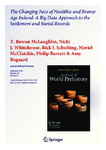The Changing Face of Neolithic and Bronze Age Ireland: A Big Data Approach to the Settlement and Burial Records
| dc.contributor.author | McLaughlin, TR | |
| dc.contributor.author | Whitehouse, Nicola | |
| dc.contributor.author | Schulting, RJ | |
| dc.contributor.author | McClatchie, M | |
| dc.contributor.author | Barratt, P | |
| dc.contributor.author | Bogaard, A | |
| dc.date.accessioned | 2016-06-16T08:06:34Z | |
| dc.date.accessioned | 2016-07-22T11:34:17Z | |
| dc.date.available | 2016-06-16T08:06:34Z | |
| dc.date.available | 2016-07-22T11:34:17Z | |
| dc.date.issued | 2016-06-10 | |
| dc.identifier.issn | 0892-7537 | |
| dc.identifier.issn | 1573-7802 | |
| dc.identifier.uri | http://hdl.handle.net/10026.1/5100 | |
| dc.description.abstract |
This paper synthesizes and analyses the spatial and temporal patterns of archaeological sites in Ireland spanning the Neolithic period and the Bronze Age transition (4300-1900 cal BC). Included are a large number of unpublished, newly discovered sites excavated through development-led projects. Data were also sourced from national archives, published excavation reports and on-line databases. Software tools were developed to deal with the varying nature and resolution of these datasets, allowing chronology to be considered in the analysis to a degree that is usually not possible in prehistoric studies. Summed radiocarbon probabilities are used to examine the dataset using context- and sample-sensitive approaches. Visualisations of spatial and chronological data illustrate the expansion of Early Neolithic settlement, followed by an apparent attenuation of all settlement activity. The Late Neolithic and Chalcolithic periods are characterised by a resurgence and diversification of activity. To assess the significance of these observations, Irish radiocarbon data are compared to an idealized model derived from North American data. Even after taking various considerations into account, human population increases can be suggested to have occurred during the Early and Late Neolithic periods. Gaps and biases in the data are discussed and priorities for future work are identified. | |
| dc.format.extent | 117-153 | |
| dc.language | en | |
| dc.language.iso | en | |
| dc.publisher | Springer Verlag | |
| dc.relation.replaces | http://hdl.handle.net/10026.1/4910 | |
| dc.relation.replaces | 10026.1/4910 | |
| dc.subject | Neolithic Ireland | |
| dc.subject | Settlement | |
| dc.subject | Burial | |
| dc.subject | Megalithic tombs | |
| dc.subject | Demographics | |
| dc.subject | Radiocarbon dating | |
| dc.title | The Changing Face of Neolithic and Bronze Age Ireland: A Big Data Approach to the Settlement and Burial Records | |
| dc.type | journal-article | |
| dc.type | Article | |
| plymouth.author-url | https://www.webofscience.com/api/gateway?GWVersion=2&SrcApp=PARTNER_APP&SrcAuth=LinksAMR&KeyUT=WOS:000380003700001&DestLinkType=FullRecord&DestApp=ALL_WOS&UsrCustomerID=11bb513d99f797142bcfeffcc58ea008 | |
| plymouth.issue | 2 | |
| plymouth.volume | 29 | |
| plymouth.publication-status | Published | |
| plymouth.journal | Journal of World Prehistory | |
| dc.identifier.doi | 10.1007/s10963-016-9093-0 | |
| plymouth.organisational-group | /Plymouth | |
| plymouth.organisational-group | /Plymouth/Admin Group - Faculty | |
| plymouth.organisational-group | /Plymouth/Admin Group - Faculty/Admin Group - FoH | |
| plymouth.organisational-group | /Plymouth/Faculty of Health | |
| plymouth.organisational-group | /Plymouth/Faculty of Science and Engineering | |
| plymouth.organisational-group | /Plymouth/REF 2021 Researchers by UoA | |
| plymouth.organisational-group | /Plymouth/REF 2021 Researchers by UoA/UoA14 Geography and Environmental Studies | |
| dcterms.dateAccepted | 2016-06-10 | |
| dc.identifier.eissn | 1573-7802 | |
| dc.rights.embargoperiod | No embargo | |
| rioxxterms.versionofrecord | 10.1007/s10963-016-9093-0 | |
| rioxxterms.licenseref.uri | http://www.rioxx.net/licenses/all-rights-reserved | |
| rioxxterms.licenseref.startdate | 2016-06-10 | |
| rioxxterms.type | Journal Article/Review | |
| plymouth.oa-location | http://link.springer.com/article/10.1007/s10963-016-9093-0 |


